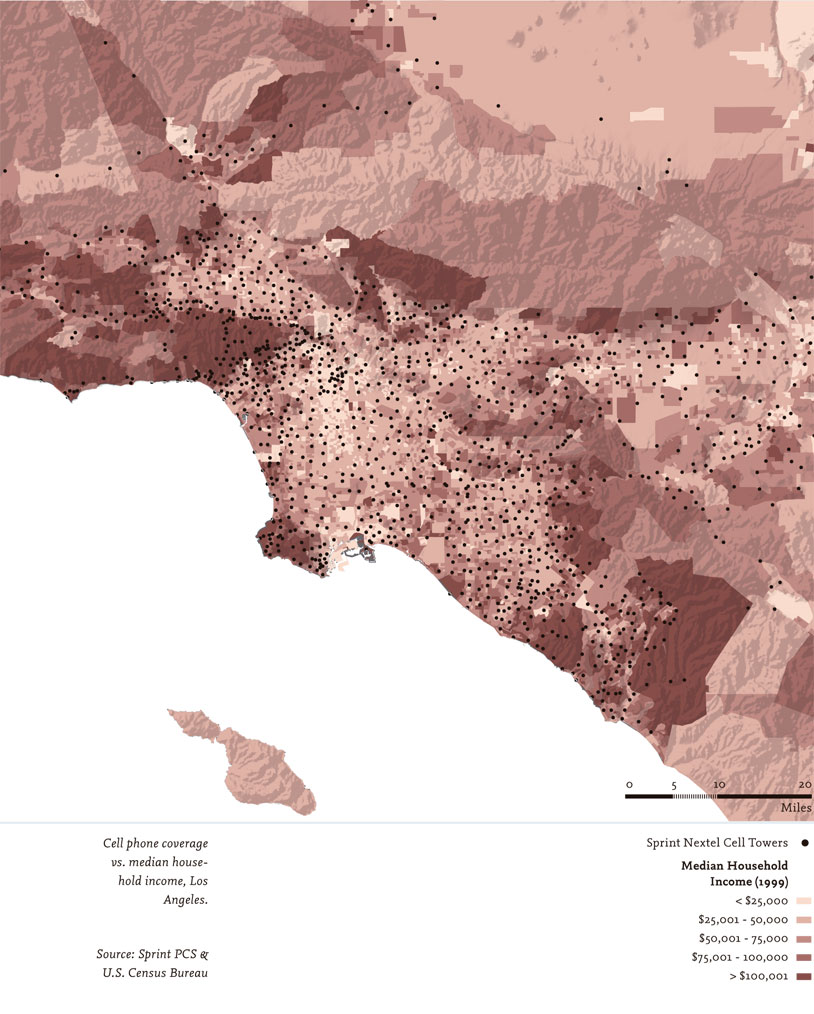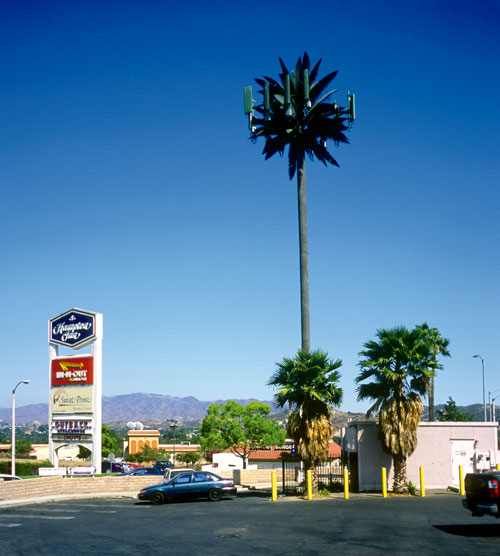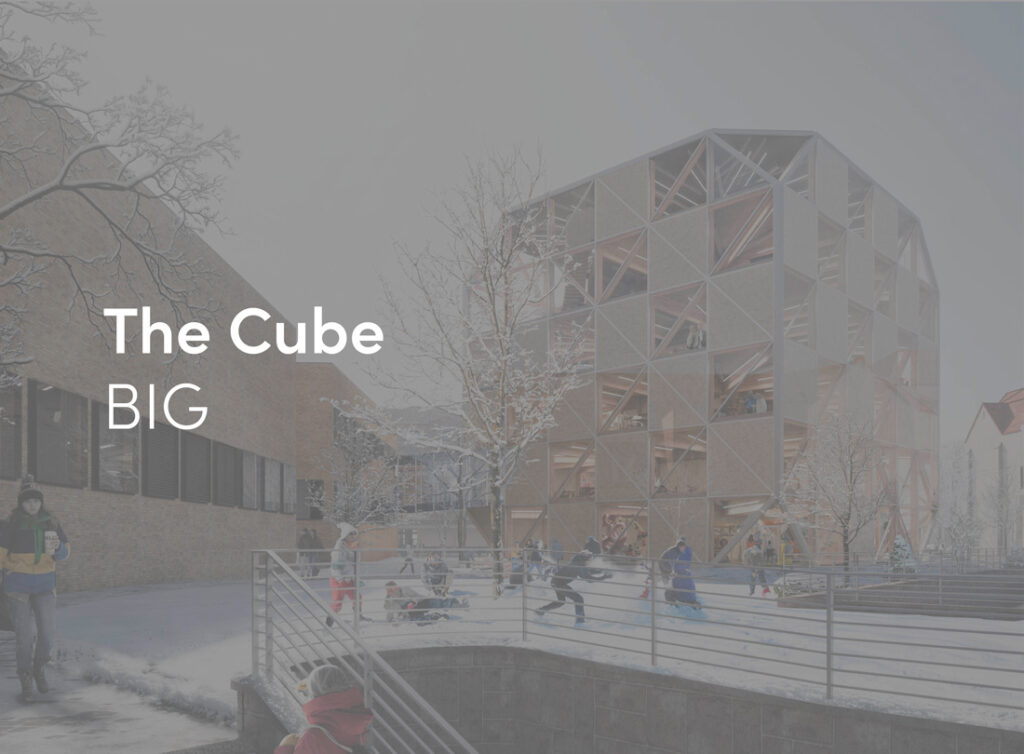A new stratum of infrastructure is settling over Los Angeles.
Unlike previous developments, this new infrastructure isn’t planned by publicly directed municipal entities but rather is developed by competing, privately operated corporations. Lacking the heroic visibility of past civil works (from Mulholland-era aqueducts to Eisenhower-era freeways), these new systems are projected along the airwaves or through fiber optic cables, inhabiting realms all but invisible to the average citizen. Even their sole outposts in the material world, cellular phone towers, seek to disappear, camouflaged as palm trees or church steeples to blend into their suburban surroundings. But the disguises need not be so clever, as the visual background noise of the city already effectively hides towers in plain sight [1]. Belying their invisibility, these new networks of communication have as much impact on the development of the city as the freeways before them. Nor is this simply a question of technology; the rise of privately funded infrastructure and the subsequent decline of public control represent a new corporate model of urban planning, with implications for the future development of the city.
Regional Patterns Los Angeles has relied on infrastructure for much of its history. Freeways, aqueducts, and dams were essential to the area’s growth into a city of over 12 million inhabitants. [2] More than anyone else, the city’s greatest hero remains William Mulholland, and, punctuating the city’s history more than any other positive accomplishments, these enormous undertakings have become emblematic of the collective urban psyche. Historically, infrastructural developments reacted to the urban needs of both private and public constituencies, addressed localized real estate interests, responded to the need for commercial links between disparate communities, and implemented Cold War defense logistics. [3]
Federal, state, and regional interests acted together to build the freeway system, elevating transportation to a public network of regional proportions, thereby permitting new trajectories of movement removed from the ubiquitous homogeneity of the urban grid. [4]
Los Angeles’s residents quickly adopted the car and celebrated the freeway for its ability to connect the larger political entity of the city while maintaining the autonomy of the individual.
The freeway imposed a different sense of place, one in which each driver is the center of his or her own universe. As Reyner Banham observed, A domestic or sociable journey in Los Angeles does not end so much at the door of one’s destination as at the off-ramp of the freeway…in part this is a comment on the sheer vastness of the movement pattern of Los Angeles, but more than that it is an acknowledgement that the freeway system in its totality is now a single comprehensible place, a coherent state of mind, a complete way of life. [5]
But if the freeway is a place, it is a place separate from the rest of the city. As the freeway connected the dispersed city, it undid any possibility of a cohesive regional plan, fueling a further dispersal of the region into a patchwork of entities each seeking greater autonomy.
The region became a city of multiple overlapping jurisdictions—a legal quagmire. Gerald Frug describes the resulting state as one in which “residents of metropolitan areas live in a multitude of legally defined jurisdictions with different borders: the areas defined by school districts, transportation districts, redevelopment authorities, park districts and the like often differ not only from city borders but from each other.”6 If the freeway provided connections to the area, it ensured that a greater sense of wholeness would not emerge as the region’s inhabitants were condemned to shuttling from off-ramp to off-ramp in tiny metal pods.
Private infrastructure flourishes in this vacuum of myopic jurisdictions, taking advantage of gaps in oversight to create new, private realms unburdened by the equal access that has historically been the obligation of utilities operating in the public realm.
Like the freeways before them, wireless networks hold out the promise to spatially liberate the citizen by connecting the city without undermining the autonomy of the individual citizen. The wireless network spans the extensive geographic breadth of the city, creating new connections where the freeway left off. However, this new infrastructure is no longer a part of a regional plan; rather it is carved out by private corporations competing for market share. These are commercial enterprises, which by their very nature are competitive yet redundant. Today in Los Angeles four telecommunications corporations—Verizon, Sprint/ NEXTEL, T-Mobile, and AT&T—operate simultaneously, stitching together independent wireless phone networks based on their own strategic models.
Though these companies are publicly held entities in legal terms (their stocks being traded on Wall Street and open to anyone to own), their day-to-day operations and the extent of their networks are shielded from public view, making it difficult for municipal authorities to influence their formation and trajectory. Opening further fissures, the Telecommunications Act of 1996 further curtailed local jurisdictional oversight by preventing states and local governments from “regulating the placement, construction, and modification of personal wireless service facilities on the basis of the environmental effects of radio frequency emissions to the extent that such facilities comply with the Commission’s [FCC’s] regulations concerning such emissions.” [7] As interpreted by the cell phone companies and defended by the Federal Communications Commission, this law has effectively eliminated the ability of local governments to oppose the construction of wireless towers in their communities. Instead local governments are limited to regulation based on community planning standards, largely imposing some form of visual control.
Camouflage The result is the camouflaged cell phone tower, the by-product of the only position available to communities who oppose cell phone towers, that is, to demand their invisibility. Hiding its presence from public view, the ubiquitous cell tower camouflaged as a palm tree becomes an appropriate icon for the private infrastructural network of our day.
Stealthy networks of towers and transmission stations span the city in a hexagonal matrix, honeycombing a sprawling metropolis already shaped by generations of commercial development. [8] Wireless phone networks have been built in stages. Because of the piecemeal construction of cellular systems and relative low cost per transmission location, the cellular industry has lent itself to a type of financing much different than the heavy construction of power lines, freeways, or aqueducts. [9] These earlier projects necessitated a large, up-front investment and long-term construction schedules, making them virtual monopolies by their nature. In contrast, the first layer of wireless networks provided thin coverage zones— generally in high-traffic, high-income areas—that produced revenue to finance perpetual growth over successive phases.
Such insubstantial and nimble systems that can be built out in stages and paid for by their own growth have transformed the rules of urban development. This new paradigm has an impact beyond wireless systems, spurring other forms of public infrastructure to seek out privatization and future development based on urban buying habits rather than public discourse. Today the private sector has assumed a leading role in energy production, education, prisons, and road systems, all of which seek to move toward a new concept of adaptability and efficiency modeled on the open market using new forms of communication and technology to monitor peak demands and cost models. The move from government-backed infrastructure to private networks has shifted power to such a degree that city governments are forced to behave like corporations in the market, competing with each other to attract the latest technological developments that corporations offer, giving tax incentives and public lands to private entities in exchange for access to the latest gadgetry.
In principle, privatization appears to be an efficient and sound strategy for extending the reach and depth of the new urban infrastructure without taxing citizenry further. Nevertheless, when we examine the implications of technology meeting the landscape, we begin to understand the real impact of this model.
Wireless coverage maps of Los Angeles expose a definable hierarchy following the dense corridors through a city where the consumer roams, while neglecting neighborhoods with less viable demographics. Wireless companies tap consumer polling, interest group research, and statistical usage data to understand the needs of the cellular citizens at the expense of the collective needs of the community. As inevitable byproducts of this hierarchical development, dead zones—areas not economical to build out as part of the network—emerge.
That parts of the city remain victims of “Swiss cheese” coverage concerns the networks only when the density of lost calls and complaints in a particular area exceeds a predetermined threshold. Although the operations of a smooth corporate hierarchy are unquestionably efficient, universal access is too expensive to be an immediate goal and the corporation is accountable to citizens only through many filters: stockholders, marketing demands, cost-benefit ratios, and the bottom line.
Wireless nodes represent a dispersed network that typifies the contemporary city at both the macro and the micro levels. The integration of the wireless network into the daily workings of the city is particularly evident in the creative industries where film and television crews come together for short durations. In this model, teams of experts form to work on a creative production with a limited duration—from a single day for a commercial, up to several months for a film—before dispersing again. Within this culture a wireless connection is a necessity for instant communication with other workers about job leads and changing opportunities. This “Network Economy,” as Manuel Castells has explained, “represents a new form of entrepreneurship in which the individual worker markets his or her human capital portfolio among various ‘buyers.’” [10] The culture of the network permeates the everyday life of the city, often times blurring the boundaries between work and leisure. Today business is transacted in spaces like libraries, cafés, and coffee shops, and not just among heavy brokers, but at all levels of network culture.
That wireless use has grown from being a luxury a decade ago to a necessity today demonstrates the importance now placed on instant communications. In the Los Angeles wireless region alone (Los Angeles, Orange and Riverside counties), network users have doubled over the last 5 years; today there are over 14.6 million subscribers to the network, in a population of 18 million. [11] We are seeing the influence of this shift beyond the middle class, into the growing economy of freelance and gray market jobs. Wireless technology is now a common tool for day laborers, landscapers, maintenance workers, mobile food vendors, and other “migratory” workers who must keep in constant touch with clients and colleagues to negotiate for and locate work. With communication freed from the confines of land-based systems and adapted to the peripatetic body through mobile phones, smartphones, and laptops), such individuals are able to leap beyond previous spatial barriers to create their own connections.
Hidden in the fabric of the city are the informal networks that sustain the contemporary economy of global Los Angeles. As Paul Virilio has observed, “we may have reached a point in the development of the city where the individual has supplanted physical territory as the dominant form of urban identity.” [12] The wireless infrastructure heightens our mobility, transforming our notion of the city; it is no longer easy to decipher where Los Angeles begins or ends (something made vaguer by telephone number portability, which attaches area codes to individuals rather than to localities). The boundaries of the city blur, as the interactions that used to happen in face-to-face transactions have now been transplanted by distance-shrinking telephone conversations, e-mail, and network connections.
Caller Identification With the personal freedom afforded by a mobile system, individuals must give up and become completely transparent to the system. With an increasing number of users opting out of land-based phones, the 911 emergency phone system and its capacity for address tracking became obsolete. In response, a 2005 directive from the Federal Communication Commission mandated that all cell phone carriers provide the ability to trace cell phone calls to a location within one hundred meters or less. To comply, the wireless industry integrated “assisted GPS” into phones, using triangulation between cell phone towers to ensure that carriers can track its customers to within approximately five meters. Perversely, although the mobile phone user is always connected and always locatable, this system is rarely made available to handset owners.
When a cell phone call begins, a signal is sent to the nearest tower, which verifies the user’s name, billing information, and authorization to use the network. Once the caller is approved, the tower connects the call, but as the caller begins to move out of range of the first tower a signal is sent out, allowing the call to be handed off to the next tower. What appears to be one phone call is actually composed of many relays over different towers, as the network constantly tracks the caller in space. The information is then cataloged in digital form, open not only to data mining to expose possible new markets or for identifying areas of call density, but also to surveillance in the name of “security.” The fundamental subservience inherent to a communication system was expressed by Jean Baudrillard: “The essential thing is to maintain a relational décor, where all the terms must continually communicate among themselves and stay in contact, informed of the respective condition of others and of the system as a whole, where opacity, resistance or the secrecy of a single term can lead to catastrophe.” [13] To be mobile, the individual becomes transparent.
Niche Markets In such an open market, the individual is increasingly vulnerable to demographic mining and subject to new forms of carefully targeted advertising. NEXTEL distinguished itself early, finding its niche with building contractors and the predominantly Mexican-immigrant construction labor force. Developed to take advantage of the two-way radio communication that had already been established in practice on construction jobs, push-to-talk technology—which acts like a two-way radio or walkie-talkie—appealed to both management and construction workers on site. But NEXTEL’s advantage had deeper implications. Though the company could only sell a limited number of phones to workers in the building trades, when accounting for other members of a construction worker’s family and social group, the target group grows exponentially. As the primary wage-earner, a laborer might be the first in his family or social group to purchase a phone, and would do so as a necessary expense of his employment. But when subsequent members move into a social or economic position to also subscribe to phone service, even if push-to-talk may not be a required feature for their use, they would have become familiar with NEXTEL via secondhand exposure to the product and would want to be on the same network as their relatives to take advantage of free mobile-to-mobile service.
NEXTEL took an early lead in the Latino market, but more telling still are the corporation’s attempts to maintain this lead. Although its marketing has relied on traditional schemes, such as underwriting concerts for Latino music, NEXTEL also undertook strategies more intricately tied to its customer base. While American companies are politically limited to the nation of their operation—agreements with a Mexican firm in which the company holds a partial stake do exist—the signal has the ability to cross boundaries unfettered. In the early 2000s, while not explicitly claiming an ability to use NEXTEL from the border regions of Baja California, billboards nevertheless made reference to the possibility that portions of northern Mexico were suddenly “in network.” Even as federal policy solidified the boundary of the United States against illegal Mexican immigration, an American corporation dematerialized the very same border to increase its appeal to a particular population that lived on both sides of that line.
Freeways, telephones, satellites, Wi-Fi, radio and television each provide means by which the everyday city flows and composes itself. This new open-ended infrastructure doesn’t dictate its form in concrete, but still has an immense impact on the life and consciousness of the city. While privately operated wireless infrastructure has had positive implications for individual freedom, allowing new opportunities for citizens to form their own connections to their surrounding community, it also exposes a troubling sovereignty now afforded corporations in the planning of American cities. Privatized infrastructure is becoming increasingly prevalent while civil institutions are declared obsolete. The privatization of governance through private police forces, prisons, school districts, and toll roads, all lead us toward a city further divided along economic lines and lacking a cohesive means of ensuring equal access. Under this private mantle urban development decisions more closely match the exchanges used in business: market share and price point find their relationship not with the public, but with other, competing infrastructures. Amortization of costs becomes part of the thought process, and those who do not fit a prescribed buying demographic are suddenly no longer part of the equation.
There is widespread faith today in the ability of the market to respond to our needs, making the activities of government seem almost irrelevant in comparison. However, as Gerald Frug has noted, there is a measurable difference between how a consumer acts individually (seeking the cheapest price for the largest return) versus how they will act when voting on government measures that can benefit the many. [14] The individual will often put the needs of society and the less fortunate ahead of his own when casting a vote for initiatives like school bonds or street maintenance. The citizen/shopper in a market system, by contrast, will only look out for his pocketbook interests, at the expense of a larger urban vision.
Fragmented and dispersed, the mega-city must come to grips with the new reality of mobile and malleable infrastructures. It has no choice but to compete with private networks. If we are to continue the development of a privatized infrastructure, we must find ways of reactivating the operative logic of the “the greater good” within the new, privatized economic regime. Like cellular networks themselves, today’s cities must form connections beyond their distinct geographic boundaries, carving new systems of interaction and collective space on a regional scale. Only in a borderless, regionally scaled city plan organized by purpose rather than geographical boundaries, can the public realm hope to compete with the smooth surfaces of corporate control.














